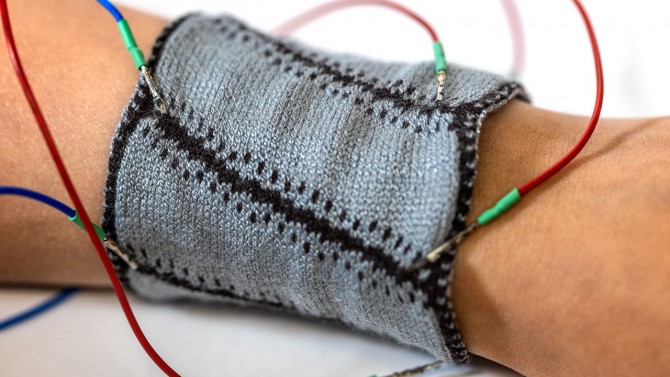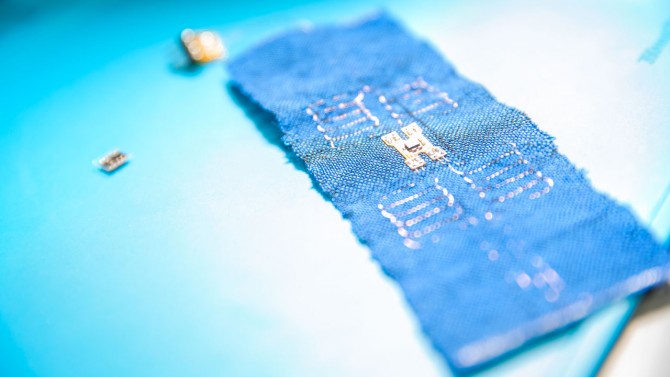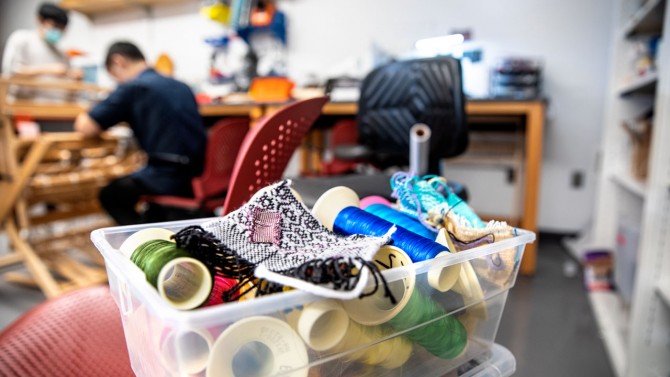Cindy Hsin-Liu Kao, assistant professor of design and environmental analysis in the College of Human Ecology, uses textile techniques from knitting and weaving to make on-skin devices that also serve as high-tech forms of expression. Graduate students Kunpeng Huang ’21 and Heather Jin-Hee Kim are first authors on award-winning papers describing the research.
Weaving inclusivity, style into wearable tech
By Susan Kelley
Cindy Hsin-Liu Kao was a doctoral student in the early 2010s when smartwatches were all the rage. As a researcher of wearable tech, she tried several. “They were doing all this amazing stuff – it’s an amazing piece of engineering, no question,” she says.
But the watches were bulky and too big for her wrists. “And the aesthetic just did not reflect who I was,” she says. “It was hard for me to wear them with everything else I had in my wardrobe.”
Kao had grown up immersed in Taiwan’s vibrant street culture, where people routinely wore false eyelashes, makeup, hair extensions and nail art. It was all temporary and inexpensive, with new designs coming out every season.
“I just started thinking, do wearables have to look like a smartwatch? Can they look things people already put on their skin – like a fingernail sticker, or a temporary tattoo or a hair extension?” she says.
Her first wearable project was a fingernail sticker with sensors that turned the wearer’s nail into a miniature wireless trackpad that she could use, for example, to discretely reply to critical messages while in a meeting.
Now an assistant professor of design and environmental analysis in the College of Human Ecology, Kao uses textile techniques from knitting and weaving to make on-skin devices that could influence arenas from healthcare to everyday interactions – and serve as high-tech forms of expression.
“Technology needs to be more diverse,” says Kao, who founded and directs Cornell’s Hybrid Body Lab, which crafts on-body technology. “A cool piece of tech is not going to be what gets people to be willing to wear on-skin devices. It’s really the design aspect, the human component: How do you create this experience, that this device empowers who you are, and what you want it to do?”
High-tech textiles
Kao’s textile techniques not only make significant contributions to the field but also make the devices more useful – and offer the potential for unlimited designs.
Until now, on-skin devices had typically been made of thin layers of silicon or polyurethane embedded with circuitry, sensors and microprocessors, stacked like a layer cake. Fabricating them is expensive. It requires a clean room to manufacture the thin layers and uses precious metals such as gold. “It hasn’t been able to become fully commercialized because of the cost,” says Kao, who has graduate field faculty appointments in the information science and in electrical and computer engineering.
In the past few years, Kao and other researchers in the human-computer interaction research community have sought to decrease fabrication costs with inexpensive materials. But the end result for these layered devices can still be cumbersome.
The stacks don’t fit well on curved or angular areas like hips or elbows. And the devices are attached to a separate battery and other components users have to carry as they wear the device. Human-computer interaction researchers usually test a device by asking study participants to wear it for 30 minutes in the lab. “But then it either breaks or has large hardware attached so it’s not fully wearable in an everyday setting,” Kao says.
She thought of a different approach in 2018 during a trip to Japan. At a Kyoto workshop that had been operating for 1,000 years, she saw artisans weave kimonos out of thin washi paper that had been coated with gold, shredded and made into long fibers. “I was like, ‘Wow, we should be weaving smart tattoos with that.”
Her inspiration developed into WovenProbe, a wireless on-skin device designed for the hand, with sensors that collect data on the wearer’s movements. It could track vital signs or hand movements while the wearer plays sports or performs surgery.
To create it, Kao’s team wove more than 20 conductive wires with yarn to create complex circuits; they connect to seven printed circuit board “islands” distributed throughout the fabric. A weaving technique called Spanish lace – a serpentine pattern that exposes parts of the skin – allows the knuckles and wrist to move without breaking the components. “It’s traditionally used for decorative purposes, but we found it to be very useful in this context for improved durability,” Kao says.
Most important, the technique can reliably integrate the entire system – microprocessor, battery and circuitry – right in the fabric substrate, with nothing extra for the wearer to carry. Kao’s team did a study in which participants wore the device for an entire workday – the first study in the field to do so. “It remained fully functional,” Kao says. “For us, that’s significant. It points to the potential for these more complex on-skin devices to finally move outside laboratories and into the hands of everyday users.”
It’s also significant for the field. Kao’s work on WovenProbe won the best paper award from ACM Designing Interactive Systems – one of the major conferences in the academic arena; first author Kunpeng Huang ’21 is pursuing a master’s degree in electrical and computer engineering. Another paper, describing Kao’s work with on KnitDermis, a knitted on-skin device, won honorable mention for best paper; first author Heather Jin-Hee Kim is a doctoral candidate in the field of design and environmental analysis.
Unlike WovenProbe, KnitDermis gives the wearer tactile feedback. It can pinch, twist or both, and exert pressure on the wearer’s skin. With machine knitting, her team encases microsprings in a series of knitted channels that move in different ways depending on the knitting pattern. That capability means the device conforms to both angular and curved areas of the body.
Worn on the neck or shoulder, KnitDermis could give a massage for pain relief; worn on the wrist, it could gently pinch when you are looking at Facebook too long or get an important text. Or it could combat emotional isolation by mimicking the touch of a loved one on the wearer’s skin during remote communication.
The team is talking with researchers at Weill Cornell Medicine about how these devices could potentially help rehabilitate stroke patients, provide therapeutic acupressure or help with lower back pain. Sensors would monitor the patient’s needs and provide the right amount of support.
“We’re building on the innate affordances of these knitting and weaving techniques,” Kao says, “and it’s really doing something that our prior stack-layer approach cannot do.”
Turning to the makers
Kao’s interest in making things stems from grandparents’ influence. Her grandmother, Kao says, was “a master maker,” an expert in mending and repair who remade blankets and other clothing into new items. “I remember very distinctly playing under her 1940s Singer sewing machine, sewing clothes for me,” she says. “She had this attitude of, ‘Just do.’ Do with your hands, and you will learn.”
Kao brings that influence to her teaching and advising. A range of students take her DEA 6040 Future Body Craft class, from engineering majors to textile designers. Kao requires they, and the students who conduct research in her lab, each learn how to knit or weave. “After a month, they’re more comfortable. And then they start thinking about new projects and they see what a powerful tool this ancient, tactile technique is.”
She asks them to think about something they wear often but don’t see on the wearable tech market. One student, who wore eyelid stickers to make her eyes appear larger, created a temporary eyelid sticker coated with electronics; it could detect blinking and sense if the wearer was, for example, reading. A Black student designed woven accessories that reflected her family’s heritage.
There’s a difference, Kao says, between a device carried on the body – like a smartwatch or smartglasses – and one that is worn, like a smart tattoo. “When you’re actually wearing it, then you start to care a lot about personal expression,” Kao says. “You ask, ‘Does this reflect who I am? Does it look good?’”
For the answer to be “yes,” the designs must reflect the wearer’s cultural perceptions. In the 1990s, celebrities like Madonna and David Beckham made tattoos popular in Western cultures. “But where I’m from, in Taiwan, and in Japan, having a permanent tattoo is associated with the ‘yakuza’ – the Mafia – so it has very different connotations,” she says. “A woman from the Middle East is going to have different considerations to wearing one of these devices, so how do you design around that?”
One of her studies found that wearers in the U.S. and Taiwan had different ideas about where on their bodies they would wear one of her prototypes, DuoSkin – an on-skin touch sensor that you can, for example, touch to answer your phone. U.S. participants were more likely to wear the device on their extremities, such as a forearm. But Taiwanese participants wanted to wear the devices in more discreet locations.
“They would say, ‘Oh, I would like it here, because I’m not sure I want my boss to see it,’” Kao says.
She hopes to simplify the fabrication so people who historically have lacked access to these technologies, such as makers, craftspeople, and even middle school children, can design and make these devices themselves. “We need diverse perspectives outside of tech for the development of these devices,” says Kao. “It cannot be only STEM researchers who are deciding what the future of wearable tech looks like. ”
With a 2021 National Science Foundation Faculty Early Career Development Award, Kao plans to run an artists’ residence in her lab to invite on-body designers like tattoo artists, fashion designers and makeup experts to experiment with the on-skin fabrication processes from her lab. The residence will start in summer 2022 and run for five years.
“If technology that goes on your skin has to look only one way, no matter who you are, I don’t think that reflects the rich diversity of human beings,” Kao says. “It’s really the diversity that makes us exciting as a species.”
Media Contact
Get Cornell news delivered right to your inbox.
Subscribe




